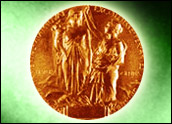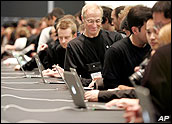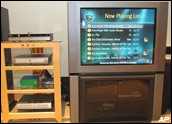
An American physicist from Chicago is celebrating a Nobel Prize win for an advanced physics concept he helped formulate more than four decades ago. Yoichiro Nambu, an 87-year-old scientist with the University of Chicago, was one of three recipients of the highly esteemed honor, announced Tuesday.
The prize spotlights the discovery of a particle physics process called “spontaneous broken symmetry.” Nambu — who was born in Japan but has been in the U.S. since the early ’50s — shares the Nobel with two Japanese physicists, Makoto Kobayashi and Toshihide Maskawa. Nambu will receive US$650,000, while the other two winners will split that sum, taking about $325,000 apiece.
Understanding the Concept
Spontaneous broken symmetry, in its most basic explanation, seems simple: Things that we observe to be symmetrical in nature can suddenly and almost randomly lose their symmetry. The concept is a key part of advanced particle physics theories, but it can be seen in everyday instances — such as if you were to place a pencil vertically on a table, with its flat eraser end balanced on the surface.
“If you just either sneeze or frankly leave the thing alone, it may not be perfectly balanced and it’ll fall off to one side or the other,” Rhett B. Herman, a professor of physics at Radford University, told TechNewsWorld.
“That is a broken symmetry,” he explained. “By virtue of coming away from that really nice symmetric straight up-and-down pose, after you just let it go for a while, the thing has fallen over and broken the symmetry.”
Broader Implications
That same idea, then, dictates the asymmetrical manner in which the world behaves on the whole.
“Spontaneous broken symmetry conceals nature’s order under an apparently jumbled surface,” the Nobel Foundation, which awards the annual honor, attests. “It has proved to be extremely useful, and Nambu’s theories permeate the standard model of elementary particle physics.”
The standard model is what’s identified with unifying the “smallest building blocks of all matter” — along with three of the four natural forces — into one theory, the Foundation says. The two Japanese physicists are credited with furthering that idea to suggest the standard model could be applied to three different families of quarks, the tiny individual parts of protons and neutrons.
Spontaneous broken symmetry is also tying into the experiments at the Large Hadron Collider — the giant atom smasher beneath the France-Switzerland border. Scientists believe the concept could help explain why matter, rather than anti-matter, makes up the universe. The Collider will attempt to replicate the conditions that were around right after the start of time to uncover those answers.
Long-Awaited Honor
The award is a long-awaited honor for Nambu, who has been with the University of Chicago for a full 40 years. His work on spontaneous broken symmetry dates back equally as far.
“Professor Nambu is one of the earliest people in particle physics who introduced the idea of spontaneous breaking of symmetry,” Kamal Seth, a professor of physics and astronomy at Chicago’s Northwestern University, told TechNewsWorld.
“[He] was the first one to draw the attention of physicists to it. … This was a big step and subsequently led to many other things by many other people,” he said.
Numerous Chicago physicists had rallied for Nambu to receive the prize, Seth explained. He himself was among the scientists who had written to the award committee to nominate him.
“What happens in physics often is that an idea is produced by somebody, but he gets missed because somebody else in some other field of physics has an idea which is believed to be worthy of a Nobel. So some people get left behind — then the Nobel committee basically comes around, sometimes very much later, to catch up with it,” Seth observed.
The honor may be delayed, but knowing that Nambu is being recognized for his achievements is more than enough for his colleagues.
“It’s just so gratifying that finally, the Nobel committee has found it right to give it to him,” Seth said.





















































